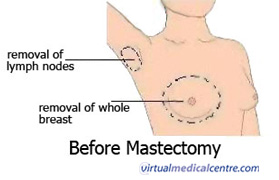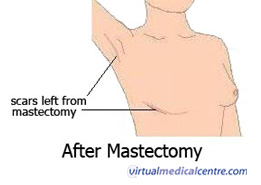- What is a mastectomy?
- Who should have a mastectomy?
- What are the risks of mastectomy?
- Breast conserving surgery or mastectomy?
- Advantages and disadvantages of a mastectomy
- Breast reconstruction and external breast prostheses
What is a mastectomy?
A mastectomy is a type of surgical treatment for breast cancer. Mastectomy means removal of the whole breast.
The images below show what the breast may look like before and after mastectomy. Two scars are usually left: one over the breast, and one in the armpit where axillary dissection is performed.

Information on re-publishing of our images
Mastectomy is often used when a breast tumour is too large to allow removal with preservation of the surrounding breast tissue (known as breast conserving surgery). Some women choose mastectomy over breast conserving surgery to avoid the need for radiotherapy.
There are several different types of mastectomy:
- Halsted radical mastectomy: This is an old procedure which is now only rarely used. It involves complete removal of breast tissue, the nipple and areola, the pectoralis major and minor (chest muscles), and axillary dissection (removal of lymph nodes in the armpit).
- Total mastectomy: This is commonly performed in Australia for treatment of breast cancer. It involves complete removal of all breast tissue, along with the overlying skin and nipple. The underlying pectoral (chest) muscles are left in place. Axillary dissection is commonly performed with total mastectomy (see below for more information about this).
- Skin sparing and nipple preserving mastectomy with immediate reconstruction: This newer technique, where the nipple and skin of the breast are preserved, and the breast reconstructed, may be appropriate for treatment of some cases of early breast cancer.
Radiotherapy is not usually required after mastectomy. It may sometimes be recommended in women who are at high risk of the cancer returning in the chest wall.
Axillary dissection refers to the removal of the lymph node in the armpit (axilla) on the same side as the affected breast. This is done because axillary lymph nodes are one of the commonest first sites for breast cancer to spread to. By removing some of the axillary lymph nodes during surgery, it is possible to find out whether the cancer has spread to these nodes. This may help plan future treatment such as chemotherapy or radiotherapy. Axillary dissection can also help by removing nodes the cancer has already spread to, reducing the likelihood that cancer will grow in the axilla.
Axillary dissection is important, but is associated with some side effects. These may include:
- Bruising under the arm, particularly in the days and weeks immediately after surgery;
- A feeling of numbness or tingling in the arm, shoulder or chest;
- Stiffness of the shoulder, which may be temporary or may remain;
- Lymphoedema: this is swelling in the arm, hand or chest which develops months or years after surgery because the normal drainage function of the lymph nodes has been impaired. This cannot be cured, but some treatments are available to reduce the swelling.
In some women who are considered at high risk of axillary recurrence (growth of cancer in the lymph nodes of the axilla), radiotherapy to the armpit may be recommended in addition to surgery.
Who should have a mastectomy?

Mastectomy may be appropriate if:
- The tumour is multifocal, ie. there is more than one tumour ‘mass’ in the breast;
- The tumour involves multiple quadrants (areas) of the breast;
- There is extensive intraductal disease, or ductal carcinoma in situ (DCIS) which cannot easily be removed;
- There is widespread microcalcification within the breast, which can make interpreting mammography of the breast difficult; or
- The tumour involves the nipple or areola.
Mastectomy is also appropriate for patients who cannot undergo radiotherapy (required after breast conserving surgery, but not mastectomy). Women may not be able to undergo radiotherapy because they:
- Have a history of connective tissue disease involving the skin (such as scleroderma). This is because people with connective tissue disease can suffer severe side effects from radiotherapy;
- Have a history of previous moderate- or high-dose radiotherapy to the chest wall, such as for previous treatment of breast cancer; or
- Have no access to radiotherapy facilities.
What are the risks of mastectomy?
A mastectomy is a surgical procedure requiring a general anaesthetic. Patients will usually stay in hospital between one day and one week.
Some side effects include:
- Some swelling or bruising around the operation sites, as well as pain, discomfort or numbness around the scars is common;
- A fluid collection known as a ‘seroma‘ may develop in or around the surgical scars. This is not dangerous but may require draining;
- Infection, or rarely bleeding, in the scar on the chest wall or in the axilla are possible;
- Following mastectomy, the difference in weight between the two sides of the body may become obvious. This can occasionally cause neck or back pain. Wearing an external breast prosthesis or undergoing breast reconstruction (see below) can help.
Breast conserving surgery or mastectomy?
Breast conserving surgery is an alternative treatment to mastectomy (removal of the entire breast). Breast conserving surgery is usually used for small, well-defined breast tumours, and is associated with better cosmetic outcomes, as only a small mass of breast tissue is removed. Women who undergo breast conserving surgery usually also require axillary dissection (removal of the lymph nodes in the armpit) and radiotherapy to the affected breast after surgery. These help reduce the risk of recurrence of the tumour. Radiotherapy is not usually required with mastectomy.
Most women offered the possibility of breast conserving surgery also have the option of choosing to have a mastectomy. The choice between these two procedures can be a very difficult one. Many women feel that a mastectomy may be ‘safer’ for them in the long term, as the whole breast is removed. However, a number of studies have been done which have shown that this is not true.
- Over a 10-year period, there is no difference in the rate of survival for women who undergo mastectomy versus those who undergo breast conserving surgery with radiotherapy.
- The rate of distant metastasis (spread of cancer beyond the breast and lymph nodes) is also no different between the two groups.
There is a slightly higher rate of local recurrence (re-growth of cancer in the affected breast) for women who undergo breast conserving surgery, compared to those who have a mastectomy. However, as shown above, this does not make any difference to survival.
Overall, breast conserving surgery with radiotherapy is considered equally as safe as mastectomy.
Advantages and disadvantages of a mastectomy
The major advantage of mastectomy is that most women do not require radiotherapy after their surgery. This may be particularly important for women who live in rural areas and do not have easy access to radiotherapy. Having radiotherapy can also be a lengthy process – most women have treatment once per day, five days a week, for five or six weeks – and there are side effects.
The most obvious advantage of breast conserving surgery over mastectomy is a better cosmetic outcome. Though breast conserving surgery does leave a scar, and the shape of the breast will be different, women who have breast conserving surgery are usually happier about their bodies and have a better self-image than women who have a mastectomy. Sexuality may be less affected after treatment. In addition, women who undergo breast conserving surgery do not need to undergo breast reconstruction surgery or have external breast prostheses fitted. Breast conserving surgery also carries a risk that the surgery will not be able to remove the whole tumour. Women who have had a complete local excision (CLE) where the surgical margins are not clear may need further surgery, including the possibility of mastectomy.
Breast reconstruction and external breast prostheses
External breast prostheses are specially designed false breasts which are worn inside a bra to give shape to clothing. They can also help to relieve posture and balance problems, and relieve stress on the back and neck. Many women find wearing a prosthesis helps them feel more comfortable and confident in public. External prostheses must be designed to fit you, matching the size and shape of your other breast. They can be expensive and must be replaced approximately every two years. Special prostheses are also available to be worn under swimwear.
Breast reconstruction surgery is another option for women who have had a mastectomy. Breast reconstruction surgery uses a variety of techniques to rebuild a breast shape. Some types of reconstruction use tissue from elsewhere in your body, for example your stomach or back, to make the shape of a breast. Others use implants made from silicone or saline.
Breast reconstruction surgery avoids the need for wearing prostheses, which may be uncomfortable or inconvenient. However, reconstruction does involve further surgery, and the results may not be what you hoped for. Complications, such as pain, infection, the need for replacement of the implant, or loss of muscle strength in the arm or stomach where a donor piece of tissue was removed are possible. Importantly, having a breast reconstruction does not increase your risk of the breast cancer returning. It also does not impair detection of cancer if it does return.
More information
 |
For information on breast cancer, types of breast cancer and its investigations and treatments, as well as some useful videos, see Breast Cancer. |
References
- Braunwald, Fauci, Kasper, Hauser, Longo, Jameson. Harrison’s Principles of Internal Medicine. 16th Edition. McGraw-Hill. 2001
- National Breast Cancer Centre. 2001. ‘Clinical practice guidelines for the management of early breast cancer: Second edition’. National Breast Cancer Centre, Camperdown,NSW. [online] Available from: http://www.nhmrc.gov.au/publications/synopses/cp74syn.htm
- National Breast Cancer Centre. 2003. ‘A guide for women with early breast cancer.’ National Breast Cancer Centre, Camperdown, NSW. [online] Available from: http://www.nbcc.org.au/resources/documents/EBC_earlyguide.pdf
- National Comprehensive Cancer Network (NCCN) 2007. ‘Clinical Practice Guidelines in Oncology: Breast Cancer’. [online] Available from: http://www.nccn.org/professionals/physician_gls/default.asp.
- National Breast Cancer Centre and National Cancer Control Initiative. 2003. ‘Clinical practice guidelines for the psychosocial care of adults with cancer’. National Breast Cancer Centre, Camperdown,NSW
All content and media on the HealthEngine Blog is created and published online for informational purposes only. It is not intended to be a substitute for professional medical advice and should not be relied on as health or personal advice. Always seek the guidance of your doctor or other qualified health professional with any questions you may have regarding your health or a medical condition. Never disregard the advice of a medical professional, or delay in seeking it because of something you have read on this Website. If you think you may have a medical emergency, call your doctor, go to the nearest hospital emergency department, or call the emergency services immediately.








